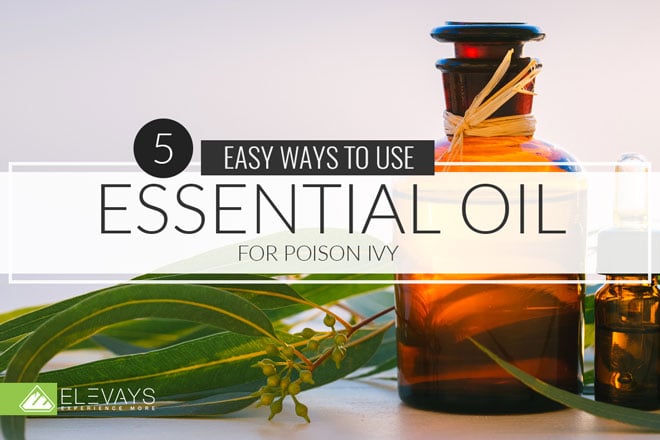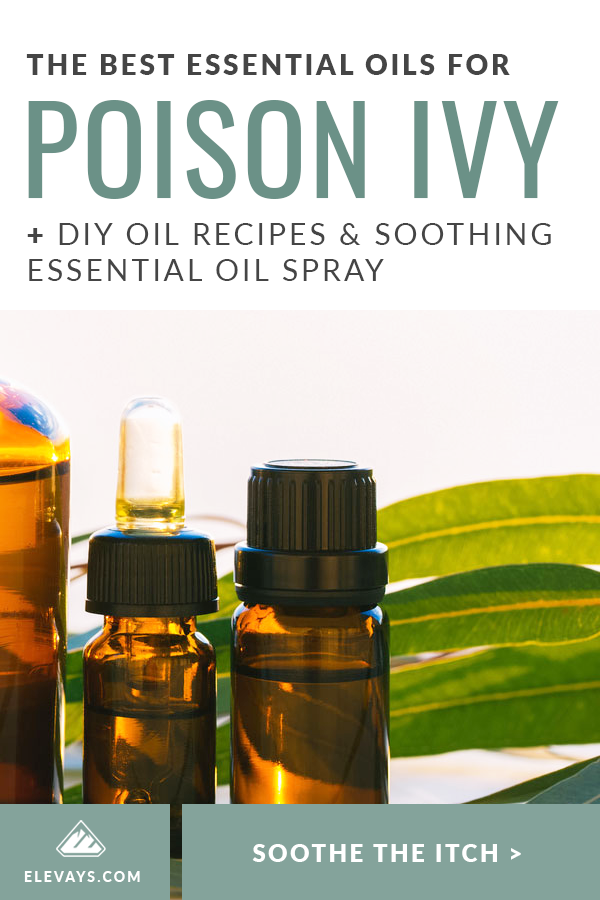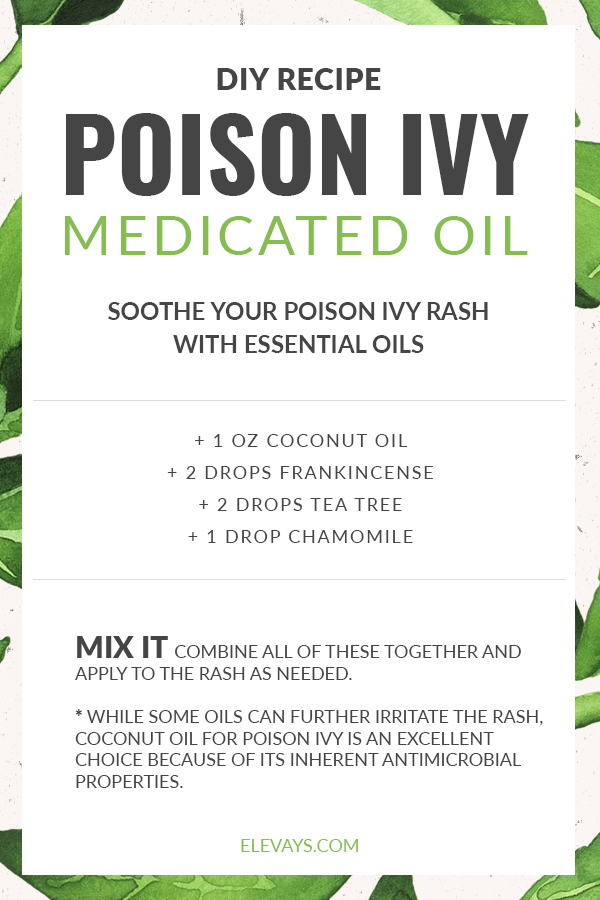If you’re familiar with poison ivy, you know there’s nothing you won’t do to get some relief. That itch is relentless. Luckily there are natural ways to prevent infection and soothe your skin without the toxic additives of most over the counter options. In fact, one of the best remedies to get you back to your itch-free days is essential oil (1).
Read on to learn more about the rash, why you should try essential oil for poison ivy relief, as well as some simple DIY recipes.
What Is Poison Ivy?
It’s actually a plant, and the itchy red rash associated with it is an allergic reaction to a sticky substance inside the plant called urushiol. Some people are more sensitive to the resin than others, but about 85% of the population will have a reaction and 15% of those will be severe (2).
TRUTH BOMB:
You’re
Already killing it!
If You Were More Consistent With Your Wellness Routine, You’d Be Unstoppable.
You come into contact with urushiol by rubbing up against the leaves, roots or stems of poison ivy, oak or sumac. You can also get it by touching contaminated shoes, clothing or even the hair of your beloved pet. The rash will usually develop within 48 hours and can last up to three weeks.
One thing to remember is you can’t get poison ivy from another person, since the blisters themselves aren’t contagious. So no need to send yourself or anyone else in your family to quarantine! (1)
By far the most effective remedy for poison ivy is not getting it in the first place. I know no one wants to hear that after the fact, but try to learn what the plant looks like so you can avoid it in the future. It is medium sized with three shiny leaves and can grow as a vine, a bush or a single plant.
If it’s too late for avoidance, the next step is to wash your body and clothing as soon as possible. Sometimes despite your best efforts, those nasty oils get in your skin and leave behind an itchy, blistery rash. So what then?
How Do You Get Relief from Poison Ivy?
Once the damage is done, you need relief. While there are many over the counter remedies, they could do more harm than good. Some hydrocortisone creams can cause the skin to thin out, blood vessels to swell and a higher risk of infection (3). Not to mention the dangers of chemical additives like propylene glycol, an ingredient in anti-freeze (4).
The quickest way to discover whether something has hidden toxins is to read the ingredients. I’ve been surprised to find a brand endorsed as “natural” to have very unnatural substances.
And the most effective remedies are usually found in nature’s medicine cabinet.
Fun fact: there is a plant often found near poison ivy called burdock. Burdock leaves can be made into a wash for poison ivy and also immediately applied to the skin for relief. Mother Nature has your back!
While essential oil for poison ivy prevention isn’t usually effective, essential oil is extremely beneficial for the rash as it can reduce inflammation and speed healing (5). So let’s get back to why essential oil is a great choice for treating poison ivy.
Best Essential Oil for Poison Ivy Options
Chamomile (Matricaria Recutita):
Chamomile is excellent both as a tea to promote rest and on the skin to calm inflammation. One study showed that applying chamomile twice a day is more beneficial than hydrocortisone (6). Keep in mind that most over the counter hydrocortisone creams have methylparaben in them, a preservative that can lead to cancer causing skin damage, especially when exposed to the sun (7).
Eucalyptus (Eucalyptus Globulus):
With a bright and refreshing aroma, eucalyptus helps to stop infection, hydrate the skin and prevent the flaking that often comes towards the end of a poison ivy breakout (8). Eucalyptus is a tree from Australia and is a great multipurpose oil to keep around the house.
Frankincense (Boswellia Carterri):
Frankincense is a powerful oil extracted from the resin of the boswellia tree. Its terpenes have potent anti-inflammatory effects that preserve healthy cells (9). The beauty of essential oils is they can be used for many purposes and usually only require a small amount to be effective.
Frankincense for poison ivy promotes skin healing and is also antimicrobial, therefore prevents against infections that may occur from scratching (9).
Lavender (Lavandula Angustifolia):
Lavender is one essential oil that should live in everyone’s home, as it calms both the mind and skin. It has a mild, pleasing aroma and one 2012 study on lavender essential oil proved that it drastically improved cellular function and inhibited inflammation (10).
Besides calming the inflammatory response, lavender essential oil is also an analgesic and helps reduce the pain of poison ivy. So not only does lavender ease pain and soothe inflammation, it also helps anxiety, making it a win all around.
Myrrh (Commiphora):
Like frankincense, myrrh is a resin made from hardened tree sap. Myrrh is antiseptic and soothing to the skin, making it an excellent essential oil for poison ivy. Its analgesic properties prevent pain and its sesquiterpenes and terpenoids, otherwise known as anti-inflammatory compounds, soothe swelling (11).
Peppermint (Mentha Piperita):
Here is another universal oil that should be found in any household. Peppermint oil for poison ivy has been shown to ease both the pain and inflammation of the rash. It is cooling to the skin and has been shown to be an effective treatment for itchiness. The scent of peppermint is also great for nausea!
Tea tree (Melaleuca Alternifolia):
A native plant to Australia, tea tree oil is great for a variety of skin conditions. The effectiveness of tea tree oil for poison ivy lies in its antimicrobial and skin healing properties. Tea tree oil reduces inflammation and speeds healing by encouraging white blood cell activity (13). Tea tree essential oil is a great addition to any medicine cabinet!
How Do You Use Essential Oil for Poison Ivy?
Essential oils are made from distilling large amounts of plant matter into a concentrated liquid. This means they are very effective in small doses. But because they’re so potent, they can also cause contact dermatitis if applied to the skin undiluted. This can easily be prevented as long as you don’t apply pure essential oils directly on a rash.
Before trying essential oil for poison ivy, try doing a small test patch on healthy skin just to make sure you don’t have an allergy to the plant (8).
Here are Five Easy Ways to Use Essential Oil for Poison Ivy Relief
A Soothing Compress:
Take a cup of warm water, preferably purified water free from chlorine, which can dry out and irritate skin. Then add five drops of essential oils, any combination from the list above will do. Get creative! Stir the water, dip a clean washcloth into your mixture and apply it to the rash. This will provide soothing relief from the swelling and itch (8).
Make an Oil:
You can make your own product by mixing essential oils with a carrier oil. While some oils can further irritate the rash, coconut oil for poison ivy is an excellent choice because of its inherent antimicrobial properties (14).
Easy Medicated Oil Recipe
1 oz coconut oil
2 drops frankincense essential oil
2 drops tea tree essential oil
1 drop chamomile essential oil
Mix all of these together and apply to the rash as needed.
Healing Clay:
Bentonite clay is another effective poison ivy treatment, as it has drawing properties that help pull resins out of the skin (5). Try making your own poison ivy clay complete with healing essential oils.
Clay and Essential Oil for Poison Ivy
1 oz bentonite clay
2 drops peppermint essential oil
2 drops lavender essential oil
1 drop myrrh essential oil
Water (as much as needed to make a paste)
Mix together and apply to the affected area. It will dry on the skin like calamine lotion, except its way more effective, with nothing toxic or damaging to the skin!
Soothing Spray:
One easy way to get an even distribution of essential oil for poison ivy on you skin without the mess of an oil or clay is to make a spray version (15). Apple cider vinegar is an effective home remedy that you may have sitting around your kitchen. Here is a recipe for a vinegar and essential oil spray.
Vinegar with Essential Oil for Poison Ivy
3 oz purified water
1 oz apple cider vinegar
5 drops frankincense essential oil
5 drops of eucalyptus essential oil
3 drops peppermint essential oil
Mix together in a glass spray bottle and spritz the affected area as needed.
This may smell strong, but is effective for several symptoms of poison ivy, including itching, swelling and any flakiness that may occur in the skin.
Make an Oatmeal Bath:
As a child you may remember being put into an oatmeal bath for chicken pox. Oatmeal is an old remedy for itchy, irritated skin and can be very soothing for a poison ivy rash. Colloidal oatmeal is most effective and can be found in many drug stores (5).
Soothing Bath with Oatmeal and Essential Oil for Poison Ivy
1 cup of colloidal oatmeal
5 drops of lavender essential oil
5 drops of eucalyptus essential oil
5 drops of chamomile essential oil
Avoid peppermint and oregano essential oils in the bath, as these could irritate delicate tissues and cause unnecessary discomfort.
Where Do I Get Essential Oils?
Just like all natural products, some essential oils are better than others so make sure they are coming from a quality source. The FDA doesn’t currently monitor essential oils, but here are a few easy tips to make sure you’re getting the best (8).
- Make sure your essential oils contain no other additives.
- Check to see that they are steam distilled or cold pressed only.
- Look to see if the country where it was sourced is listed on the bottle.
- Check to make sure that the plant’s Latin or botanical name is listed as well as the common name.
If you want more details on where to buy essential oils, check out our post here on all the details.
Is Poison Ivy Dangerous?
While a poison ivy rash is irritating and can cause itchy restless nights and aggravation, it usually isn’t cause for too much concern. However, certain complications can arise from contact with poison ivy.
Try your best to avoid scratching! There are a lot of bacteria living under your fingernails that can get into the already irritated skin and cause infection. This is especially important for little ones.
Inhaling smoke from poison ivy could be dangerous and cause lung damage. Or you could have a severe allergy without being aware of it.
Here are Some Reasons to See Your Healthcare Provider
- Pus coming from the blisters (this could be a sign of infection!)
- If breathing is painful or there is severe swelling.
- You’ve inhaled the burning smoke of poison ivy.
- The rash has spread to the mouth, genitals or eyes (16).
If you have any trouble breathing or your throat beings to swell, get to the emergency room immediately! This could be a sign of severe allergic reaction.
Now that we’ve covered the ins and outs of how to use essential oils for poison ivy, I’d love to hear what you think. Have any of you suffered that dreaded itch from poison ivy or poison oak? Do you have any stories or recipes to share? Leave a comment below and tell us about it!
For more information on essential oils, check out our Ultimate Essential Oils Guide!
Sources
- Healthline, (2018). The Best Essential Oils for Poison Ivy and How to Use Them. Retrieved from: https://www.healthline.com/health/essential-oil-for-poison-ivy
- American Skin Association, (2012). Poison Ivy, Sumac and Oak. Retrieved from: http://www.americanskin.org/resource/poisonivy.php
- Net Doctor, (2015). Topical Corticosteroids. Retrieved from: https://www.netdoctor.co.uk/medicines/skin-hair/a3662/topical-corticosteroids/
- Dr. Axe (2018). Propylene Glycol: The Complicated Additive with Potentially Dangerous Side Effects. Retrived from: https://draxe.com/propylene-glycol/
- Dr. Axe, (2018). Top 5 Natural Remedies for Poison Ivy Rash. Retrieved from: https://draxe.com/poison-ivy-rash/
- Charousaei, F., Dabirian, A., & Mojab, F. (2011). Using chamomile solution or a 1% topical hydrocortisone ointment in the management of peristomal skin lesions in colostomy patients: results of a controlled clinical study. Ostomy-Wound Management, 57(5), 28. Retrieved from: https://www.ncbi.nlm.nih.gov/pubmed/21617262
- Healthline (2018). What You Should Know Before Using that Product That Contains Methylparaben. Retrived from: https://www.healthline.com/health/methylparaben#safety
- Healthline, (2018). The Best Essential Oils for Poison Ivy and How to Use Them. Retrieved from: https://www.healthline.com/health/essential-oil-for-poison-ivy
- Dr. Axe, (2018). What is Frankincense good for? 8+ Essential Oil Benefits and Uses. Retrieved from: https://draxe.com/what-is-frankincense/
- Huang, M. Y., Liao, M. H., Wang, Y. K., Huang, Y. S., & Wen, H. C. (2012). Effect of lavender essential oil on LPS-stimulated inflammation. The American journal of Chinese medicine, 40(04), 845-859. Retrived from: https://www.ncbi.nlm.nih.gov/pubmed/22809036
- Dr Axe (2014). 10 Proven Myrrh Oil Benefits and Uses. Retrieved from: https://draxe.com/myrrh-oil/
- Healthline (2017). 9 Benefits and Uses of Oregano Oil. Retrieved from:
- https://www.healthline.com/nutrition/9-oregano-oil-benefits-and-uses
- Healthline (2017). 14 Everyday Uses of Tea Tree Oil. Retrieved from: https://www.healthline.com/nutrition/tea-tree-oil
- Healthline (2016). 31 Clever Uses for Coconut Oil. Retrieved from: https://www.healthline.com/nutrition/31-coconut-oil-uses
- Dr. EricZ, (2018). Essential Oils for Poison Ivy Treatment Recipe. Retrieved from: https://drericz.com/essential-oils-for-poison-ivy/
- WebMd. Allergies to Posion Ivy, Oak and Sumac (2018). Retrieved from: https://www.webmd.com/allergies/poison-ivy-oak-sumac – 1








READ the Latest
Longevity
Health Habits
Health Habits
Longevity
2 Comments